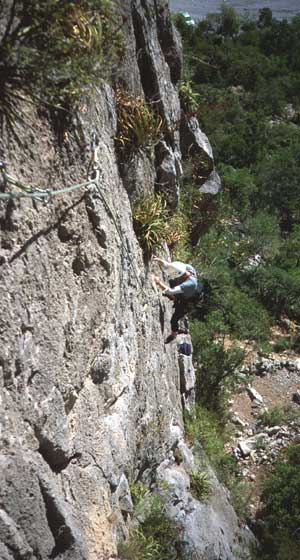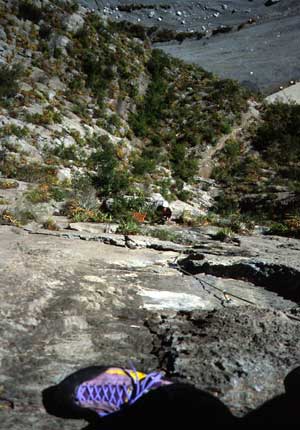I was not calibrated to the rock, and we were certainly not warmed up on this typical chilly morning, but the holds were all there, and I paused only once to work out a sequence of moves over a short section where the wall steepens a bit. The rock here is limestone, often some of the most climbable rock to be found. It weathers quickly in the rain, so abundant holds can often be found on a wall that looks smooth and unclimbable from a short distance away. Friction is excellent, and I was enjoying the ability of my new 5.10 Anasazi slippers to stick to almost anything I applied them to. Compare to my old 'all-day' shoes, these seemed to have Velcro on the soles. After pulling the crux, I thought "if that's what the climbing will be like all week, we're going to have a great time!" I mentally rated it as stiff 5.9. Soon I got to enjoy the first palm tree belay. I'm pretty sure this is the first time I've ever belayed on a vertical wall standing on the trunk of a palm tree.
Lynn had to rest on the rope at the crux, and we both chided ourselves for not spending more time in the gym before arriving, but then, isn't that always the case. The next two pitches went smoothly. Both were quality, but not as memorable as the first. There was a final short incongruous 5.7 pitch that provided access to a relatively level spot where we could enjoy the view and take off our shoes for a while. That night we strongly recommended the climb to Ellen and Mandy as a moderate area classic. However, when we finally were able to purchase the supplemental guidebook, we discovered that the pitches are rated 5.10+, 5.10, 5.10, 5.7. Our first pitch in the Portero was near my usual leading limit - either we were taking well to the limestone, or the ratings are soft. I suspect a little of both.

Lynn Clark following the first pitch of "Diablo's
Path"
The rest of the week unfolded pretty much as expected. Now calibrated to the ratings (which were surprisingly consistent), we targeted 5.10 and 5.10+ climbs almost exclusively, finding that we could fill 10 days of climbing without worrying about running out of routes. When the density of climbers became such that it was either "jump on what's available, or don't climb", we repeated a few pitches we had done in 2000, but other than those, all routes were new. We did 51 pitches total, which is not a lot when you consider that the typical Portero pitch is 30m. On a couple of the days we deliberately kicked back to give the fingers a rest and take care of chores in town, but even on those days we got in at least 3 pitches. On one such day we decided to get away entirely, and drove 30 miles to the west to see some new scenery and get away from the crowds. An anecdote from this excursion goes a long way toward illustrating one of the most positive aspects of traveling in this part of the country - the "Norteanos", as they call themselves, are some of the friendliest, most hospitable people I've encountered anywhere in the world.
We were looking for a remote area of rock domes on which, the guidebook indicated, there were some worthwhile routes. Finding the domes was tricky. The guidebook for Potrero, "Mexican Rock" by Jeff Jackson, is one of the poorest I've ever seen, with vague and incomplete information throughout. In this case, it appeared the author had never actually been to the area, or was going out of his way to be vague. After some detours in the desert, we thought we were at the correct lumps of rock - two rather picturesque, isolated domes that looked like they should offer some decent climbing. Driving up to a gate, we packed the ropes and headed up a decidedly unfriendly approach of talus liberally decorated with vicious spiny plants. The route we were looking for was a 5.10 finger crack. It was not where the guidebook said it should be, but further to the west, which posed a problem. We had to decide whether to cross a fairly serious looking fence. In the US, crossing a fence can often mean you are trespassing, and we weren't anxious to deal with an irate landowner in this environment.
Finally I opined that this was probably just a "cow fence", similar to those on BLM land in the US, which supposedly belongs to all the people, but everyone knows actually belongs to cattle ranchers. I crawled over, noting that the barbed wire was no worse than all the plants we had been fighting our way through. Lynn stayed at the fence while I made my way to the base of a vertical buttress that looked to be the right one. Down in the valley, I could see some shacks, but I quickly concluded that nobody could live in them. Then the dogs started barking. Soon someone appeared at a door. Lynn was getting anxious, but I was determined to at least see if I'd found the route. By the time I was at the base, people were spilling out of the house, headed up the road toward our car. The finger crack was there, all right, but the guidebook had failed to mention that there was no fixed pro on these routes - I needed a rack of cams. This might seem obvious, but 95% of the routes at Portrero Chico are bolted, and the book had always pointed out when any gear besides draws was necessary - another inconsistency.
It was time to leave. While picking my way down slope, I mentally practiced the appropriate Spanish translations for such as "Is that thing actually loaded?" and "Sorry, we're just dumb Gringo tourists who don't' know what a fence means." I had hoped to get to our car, which was parked a good quarter mile from the house, before the irate landowner, his wife and children, and 3 barking dogs did, but it was soon clear I wouldn't make it. We arrived simultaneously, with me mentally on edge, expecting a confrontation in which I was at a clear disadvantage. To my "Buenos Dias", he responded in kind, then added:
"Would you like me to open the gate so you can drive in closer?"
I was so keyed up I was completely at a loss for how to respond. This guy and his entire family had hiked about a quarter mile just to let us through the locked gate! I muttered "Gracias, no, nos vamos", as we dumped our packs in the trunk and got in the car to leave.
We drove a short distance down the road, then decided to climb a nearby peak, thinking it was so isolated and undistinguished that we might be the only people to have done so in modern times. When we arrived on the summit a few hours later, we found a four-foot cairn. The day was perfect: T-shirts in sunshine, with a slight breeze.
Back at the Portrero, we managed to get in a couple of the local classics. At this time of year (Xmas-NYD), you must be at the base before first light to get on one of these all-day routes. Indeed, even that wasn't good enough for one of the routes, and it took two attempts on successive mornings to be first in the queue. The climbs, which I highly recommend, were both on the "Jungle Wall", one of the most accessible and desirable because it gets substantial sun on a winter day and because all the routes on this wall are quality and multi-pitch. The first was Black Cat Bone, 9 pitches of mostly 5.9 and 5.10 with one sustained 5.10+ pitch culminating in a wildly exposed roof. The second is one of the longer routes at Portrero - Yankee Clipper, 14 or 15 pitches with three 5.10 pitches (the guidebook claims four, but pitch 14 is way overrated)

Looking down from pitch 6 of "Black Cat Bone"
Other highlights included the three main routes on the "Conundrums" - The Raven, The Rattler, and Apeman. Each of these comprises three 30m pitches of 5.10. The book claims 5.11 for pitch 2 of "The Raven", but with careful route finding we found it only sustained 5.10. This was one of the best pitches we climbed on the trip, but my favorite pitch was the central route up "La Ola". This 5.10 full single-pitch route culminates in one of the coolest roofs around, composed of accreting limestone in the same fashion as underground cave formations. A must-do.